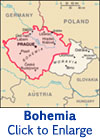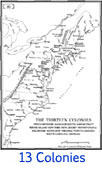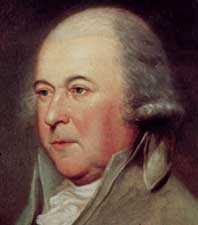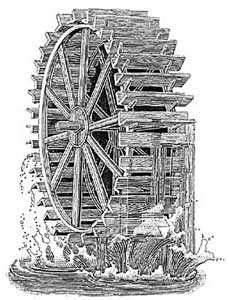Sample Teacher Resources/Lesson -- Upper Elementary-Middle School
David Saxe, Penn State, College of Education, Department of Curriculum and Instruction
Introduction


The colonial community at Bethlehem, Pennsylvania was a beehive of activity
and enterprise. Bethlehem was a special place. Here settlers with roots in
Bohemia and Moravia (in what are now the Czech Republic and Slovakia)were
given the chance to make new homes for their families. These settlers, called
Moravians, were very religious people. The Moravians came to America primarily because America offered a great opportunity to spread God's word. They believed their
purpose was to become missionaries to the Indians and other German families
who lived in Eastern Pennsylvania.
To accomplish this task—to be missionaries to Indians and German settlers—the
Moravians built an amazing community, a model of what we might call the forerunner of a
modern industrial complex. This was very unusual for colonial America.
Most people who lived on the frontier worked very hard to build farms
and produced only enough to feed their families. Since Moravians wanted
to provide religious services to other people and not everyone
could be a missionary (and missionaries had to devote themselves to visiting
the Indians and other settlers and could not farm or do other work), they
had to develop a system to support the work of missionaries.
From the earliest beginnings of America, nearly all the people on the
frontier worked to support only themselves and their families. Even in
the 19th century,most communities were primarily agrarian, involved chiefly in the activities of growing
food and tending stocks of animals. At Bethlehem, before the Revolutionary
War, the Moravians managed to reverse the existing work model by employing
80% of their citizens in trades and manufacturing with only 20% working
to support the entire community with food. That was a very important development,
a new idea.

This
new idea attracted the attention of John Adams (then Member of the
Continental Congress and future second president of the United States).
Adams came to Bethlehem in January of 1777. By this time, the Patriots
had declared
their independence from England (July 4, 1776). This was a dangerous
time and war was a constant threat throughout the former colonies
now struggling for their independence. Still, Adams found time
to visit Bethlehem. What he found there amazed him. Adams called
Bethlehem a “curious
and remarkable Town,” immediately recognizing the importance of
this community for the future of the United States—Bethlehem
demonstrated what was possible: how opportunity, freedom, and
liberty could be applied to build a prosperous and happy community.
Adams had seen the future of America.

What made
Bethlehem so amazing? The center of the community was its manufacturing
which spawned more than fifty crafts and industrial trades. One of the
most important parts of the community was its system of mills, especially
its gristmill which, provided everyone the flour to make his or her daily bread—the
staple of the community.
Here in Bethlehem, Old World technologies mixed with the opportunities of
the New, creating unimagined results. At first, Bethlehem was controlled
by Church authorities: as the nuclear family of husband-wife and children
was unknown and individuals were separated by gender. All was done for
the good of the community. This social-economic model worked as long as Bethlehem
was relatively isolated from other communities.
By the 1750s, just before the French and Indian War, the wider colonial
world became connected to Bethlehem. The community began to trade tanned
hides, linseed oil, food stuffs, and other products to outsiders in exchange
for iron, gunpowder, glass, and salt.
To improve trade, the Moravians established stores and inns for visitors
and soon Bethlehem became a center of trade between Moravians and other
colonial people.
This greater trade increased wealth and prosperity. These new opportunities
to make money also created a new demand among Moravian tradesmen and craftsmen,
who began to establish their own businesses. Soon a new system of economics
was established: market capitalism.
Individuals set up their own businesses to sell and trade independently
of church (or state) restrictions. This new opportunity created a strong
independent entrepreneurial spirit among the Moravians and other colonial
people.
The Bethlehem experience was one indication among others that, long before the Revolutionary War, the beginnings of capitalism and
a government system to support it were evolving in the colonies. While the Declaration of Independence created a new nation, it also confirmed
and protected a new economic system that was to spread throughout the
emerging United States of America. On that count, Bethlehem provides an
excellent case study for the study of early American life and institutions;
how Old World ideas and technologies were applied and improved in America;
how freedom and liberty created unimagined opportunities to improve the
lives of Americans.
Background Essays
The section on 'Historic Bethlehem' in the '
In-Depth Articles' contains much informative material on Historic Bethlehem from the Historic Bethlehem libraries. In addition, the lesson plan material on Historic Bethlehem from the National Park Service provides a valuable resource for teachers (see links below).
- Colonial America's Pre-Industrial Age of Wood and Water,
Historic Bethlehem
Article on the colonial economy and its technology.
- Perfection in the Mechanical Arts: The Development of Moravian Industrial Technology in Bethlehem, Pennsylvania, 1741-1814,
Stephen Cutliffe & Karen Huetter/Historic Bethlehem
Article on Bethlehem's contribution to American technological development because of its early concentration of industrial technology.
- Oil Mill Industries at Bethlehem/Technology of the Oil Mill Industries,
Historic Bethlehem
Story of the oil mills at Bethlehem's Moravian community.
- The Grist Milling Process,
Historic Bethlehem
Article on the milling of flour in Pennsylvania. Explanation of how a grist mill works.
- The Bakery at the Moravian Community, Bethlehem, PA,
Historic Bethlehem
Story of the bakery at Bethlehem's Moravian community.
- The Significance of the Bethlehem Waterworks,
Historic Bethlehem
Article on the Bethlehem waterworks, the first pumped municipal water system in the colonies.
- Stronger than One Hundred Men: the Vertical Waterwheel,
Historic Bethlehem
Article on the critical importance of the vertical waterwheel to Western technology, specifically the community at Bethlehem, Pennsylvania.
Steps
First Steps:
In learning about Bethlehem, teachers might begin with a list of colonial
jobs or tasks. Building
from earlier lessons on mills, mill
technology, trades, and
agriculture, teachers
could identify how the community was organized. Teachers could discuss
the relationships between fields, waterways, farms, homes, churches,
stores, and manufacturing areas, including modes of transportation.
To gain a greater appreciation and understanding of the organizational
structure of Bethlehem, have children plot the various structures and
places of work on a map. Teachers might also have their children color
in the structures, fields, forests, water features, roads, structures,
and other items:
Colonial Pennsylvania Mills,
Mills in Colonial Cities, Geography, Landscape and Mills.
To understand how milling is closely connected to waterways, teachers
will show how millers used the water to produce energy:
The Three Types of Waterwheels.
To understand and describe how mills operated, teachers will show basic
models of mills:
The Three Types of Waterwheels,
Mills and Machinery from Medieval to Colonial Times.
Next Step: What Products Did the Mills Produce and How Were These Marketed?
We know that mills were a central part of every colonial community,
especially the gristmill. Everyone needed corn meal and flour to make
bread. Manufactured flour was of higher quality than stone ground products
made by hand at home. Flour also differed in quality, as well as in the type of grain from which it was made. Teachers will explain
the uses of flour in cooking and baking, the products produced in baking,
and the distribution and sale of these products throughout the community.
There were other sorts of mills at Bethlehem, which also very
important to the community and its growth. In addition to the gristmill
that made flour, a fulling mill and oil mill produced other needed products
that were sold for cash and trade. Teachers will explain how the fulling
mill featured power-driven technology that greatly increased
the quantity of wool products. The oil mill was used to
produce linseed oil that was pressed from flaxseed grown locally.
Concluding Step (for this section): Bread Builds Communities
The backbone of every successful colonial community
was the quality and quantity of its food supply. With its agricultural
practices and applications of advance technologies, the Moravians at Bethlehem
were able to achieve a higher standard of living than was available in
Europe or in other parts of the colonies. The success of Bethlehem was
due to the blending and application of agriculture and industry. It is
also important to note that the revolution of new technologies, ideas,
economics, and manufacturing came in advance of the coming revolution
in government. During the Revolutionary War, patriots established a government
that would support and encourage this amazing pre-industrial world. The
lessons learned at Bethlehem and other communities proved invaluable as
the new American citizens transitioned from the colonial period to the
early nation era.
In thinking about the successes and failures of Bethlehem, teachers
can lead students in discussions that require students to think about
the inner-relationships necessary to build a strong community, the divisions
of labor, the various tasks and trades, the importance of manufacturing,
the need for genius of invention to improve technologies, increase output
and wealth (capital), and raise the general quality of life for all.
Learning Objectives
Things that students should do and know
Depending upon the needs of teachers and students, teachers can select,
mix, match, or collapse any of the suggested following objectives]
- Recognize how opportunity builds community
- Create a map showing the homelands of the Moravians, routes of immigration, and settlement in Pennsylvania
- Identify what Bethlehem was like before the Moravians came, then identify how the Moravians acquired title to the land and also changed and improved the it for their own purposes
- Identify, define, and explain the various terms associated with life in colonial Bethlehem
- Explain/demonstrate how Bethlehem was considered a model of a closed community (self-contained/self sufficient)
- Identify the ways of living brought to the New World from the Old, and identify adaptations, improvements, and creations of new ways of living established in Bethlehem
- Name and explain the various trades and manufacturing projects found in colonial America (at Bethlehem)
- Explain how agriculture supported industry (and what made Bethlehem unique in the colonial world)
- Explore how Bethlehem solved the problem of fulfilling their missionary work while supporting and sustaining a thriving community
- Identify what daily life like for the citizens of Bethlehem, provide examples of how life differed through the four seasons
- Name the various mills found at Bethlehem and describe the use and products of each
- Demonstrate the improvements, productivity, efficiency, and possibilities that water-driven machines provide over manual labor
- Identify what impressed John Adams about life in Bethlehem
- Identify the community, social, and family relationships found at Bethlehem, particularly the roles of men and women, and especially the place children
- With given maps of the industrial complex at Bethlehem, explain why colonial Moravians placed the various structures for crafts and industries
- Identify the basic operation of the mill
- Name the various products of milling
- Identify the various crops and meats and other foods produced at Bethlehem
- Compare and contrast the diet of colonial Moravians to that of contemporary Americans
- Outline the growth of colonial Bethlehem and assess its success
- Explore the reasons why Bethlehem changed from a closed community to one more connected to life outside of Bethlehem, Pennsylvania.
Strategies
Colonial Bethlehem was established as a self-contained,
independent, and self-sufficient community—a world unto itself.
This concept of a self-contained community is readily understood
by children, who psychologically interpret their own understanding of
the world as the immediate community surrounding themselves).
Building from this basic understanding, provide an overview of the Bethlehem
community, the basic tasks of living, the daily work, planning, and construction
(reminding the children that the initial underlying purpose of Bethlehem
was its missionary work).
- Beginning with maps and map making, introduce the world of Bethlehem to children
- Discuss the various reasons people came to America; include reasons why the Moravians came
- Introduce the practices and customs of daily life pertaining to foods, tasks, beliefs, clothing, agricultural practices, and animals, which the Moravians brought to Bethlehem
- Have children role-play various types of individuals, exploring and demonstrating how they lived and worked in Bethlehem
From these suggestions, apply specific lessons from the list of objectives
given above (i.e. make foods, create models, write stories, draw and paint
objects, buildings, people etc.)
Applying State Standards to Lessons
It is now well known throughout the educational world, that given the
application of No Child Left Behind requirements together with various
state testing programs and schemes, the specific introduction and study
of American history, civics, economics, and geography in elementary and
middle schools has been radically altered, if not seriously impacted.
Every teacher knows that the thrust of educational effort has been centered
on the subjects of mathematics and language arts. While math and language
arts (including reading and writing) are extremely important, it is problematic
that what is tested is taught because, collaterally, what is not tested,
is often not taught at all.
In simple pragmatics, recognizing the prevailing structure of schooling—recognizing
the diminished place American history holds in schools, the most effective
means for teaching American history topics is through inclusion within
language arts, specifically reading and writing exercises. The application
of American history and in this case the study of colonial Bethlehem provides
teachers with opportunities to cover not only crucial language arts standards,
but also history and other related standards.
The application of American history topics has collateral benefits for
language arts. Specifically, American history topics spark interest and
create enthusiasm. Language arts programs can provide only so much interest
to children, and the presentation of historical people, the study of life
in other times, the connection and continuity of colonial living to life
in contemporary America brings depth and understanding.

 The colonial community at Bethlehem, Pennsylvania was a beehive of activity
and enterprise. Bethlehem was a special place. Here settlers with roots in
Bohemia and Moravia (in what are now the Czech Republic and Slovakia)were
given the chance to make new homes for their families. These settlers, called
Moravians, were very religious people. The Moravians came to America primarily because America offered a great opportunity to spread God's word. They believed their
purpose was to become missionaries to the Indians and other German families
who lived in Eastern Pennsylvania.
The colonial community at Bethlehem, Pennsylvania was a beehive of activity
and enterprise. Bethlehem was a special place. Here settlers with roots in
Bohemia and Moravia (in what are now the Czech Republic and Slovakia)were
given the chance to make new homes for their families. These settlers, called
Moravians, were very religious people. The Moravians came to America primarily because America offered a great opportunity to spread God's word. They believed their
purpose was to become missionaries to the Indians and other German families
who lived in Eastern Pennsylvania.

 This
new idea attracted the attention of John Adams (then Member of the
Continental Congress and future second president of the United States).
Adams came to Bethlehem in January of 1777. By this time, the Patriots
had declared
their independence from England (July 4, 1776). This was a dangerous
time and war was a constant threat throughout the former colonies
now struggling for their independence. Still, Adams found time
to visit Bethlehem. What he found there amazed him. Adams called
Bethlehem a “curious
and remarkable Town,” immediately recognizing the importance of
this community for the future of the United States—Bethlehem
demonstrated what was possible: how opportunity, freedom, and
liberty could be applied to build a prosperous and happy community.
Adams had seen the future of America.
This
new idea attracted the attention of John Adams (then Member of the
Continental Congress and future second president of the United States).
Adams came to Bethlehem in January of 1777. By this time, the Patriots
had declared
their independence from England (July 4, 1776). This was a dangerous
time and war was a constant threat throughout the former colonies
now struggling for their independence. Still, Adams found time
to visit Bethlehem. What he found there amazed him. Adams called
Bethlehem a “curious
and remarkable Town,” immediately recognizing the importance of
this community for the future of the United States—Bethlehem
demonstrated what was possible: how opportunity, freedom, and
liberty could be applied to build a prosperous and happy community.
Adams had seen the future of America.
 What made
Bethlehem so amazing? The center of the community was its manufacturing
which spawned more than fifty crafts and industrial trades. One of the
most important parts of the community was its system of mills, especially
its gristmill which, provided everyone the flour to make his or her daily bread—the
staple of the community.
What made
Bethlehem so amazing? The center of the community was its manufacturing
which spawned more than fifty crafts and industrial trades. One of the
most important parts of the community was its system of mills, especially
its gristmill which, provided everyone the flour to make his or her daily bread—the
staple of the community.
